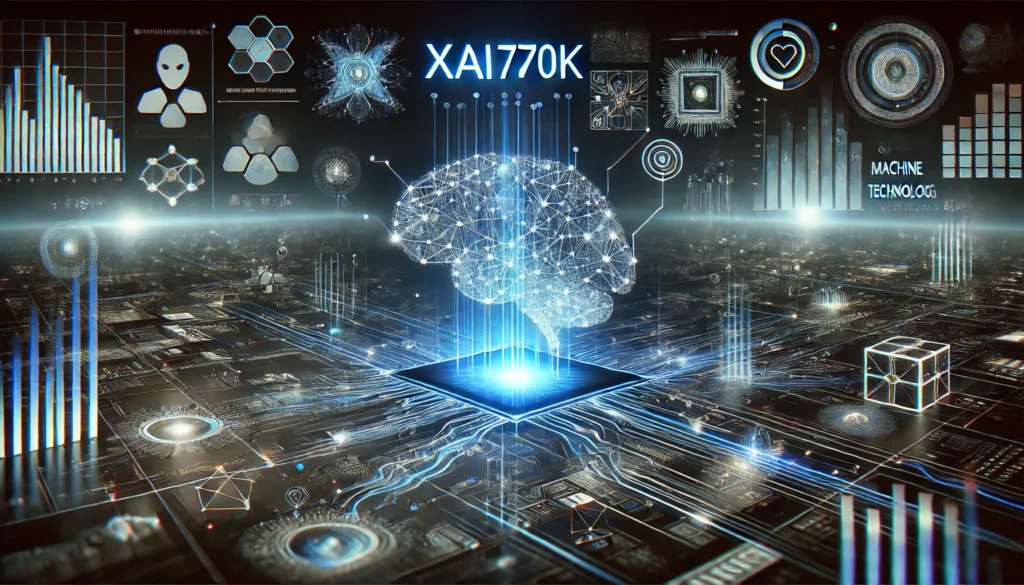Artificial intelligence (XAI770K) has made tremendous strides over the last few decades, profoundly revolutionizing numerous industries and shaping the future. Among the most exciting recent developments in AI is the XAI770K, a cutting-edge technology that promises to push the boundaries of what AI can achieve. This article explores the evolution, features, applications, and challenges surrounding XAI770K, shedding light on its potential to transform the technological landscape.
The Evolution of XAI770K: From Concept to Reality
The journey of XAI770K began within the broader context of AI research and development, where the quest for more powerful and efficient systems has been ongoing for years. Early AI systems were based on simple algorithms that could perform data classification or pattern recognition tasks. Over time, these systems grew more sophisticated, leading to the emergence of deep learning, machine learning, and neural networks.
XAI770K represents a significant leap forward in the evolution of AI. It builds upon decades of work in the AI field, integrating the latest advancements in machine learning and natural language processing (NLP). Developed by a collaboration of top researchers and technology companies, XAI770K incorporates a range of advanced algorithms that enhance its ability to understand and process information. The system’s architecture is designed to handle massive datasets, perform complex computations, and execute tasks that were once thought to be beyond the capabilities of artificial intelligence.
One of the key milestones in the development of XAI770K was its ability to adapt to real-world environments and learn autonomously. This ability to self-improve and refine processes through continuous learning makes it a standout system in the AI landscape. The result is a technology that can analyze vast amounts of data, recognize patterns, and make decisions with minimal human intervention, making it a valuable asset across various industries.
Key Features and Capabilities of XAI770K
XAI770K has advanced features and capabilities that set it apart from traditional AI systems. Its hardware specifications include ultra-powerful processors capable of handling millions of operations per second, allowing it to process large datasets in real time. This high-performance hardware is essential for the system to perform complex tasks such as predictive analytics, speech recognition, and natural language understanding.
One of the standout features of XAI770K is its deep learning algorithms, which enable it to recognize patterns and make informed predictions with incredible accuracy. These algorithms are trained on massive datasets, allowing the system to improve its performance continuously over time. Unlike previous AI models that required human intervention to adjust or retrain the system, XAI770K can autonomously refine its algorithms, making each iteration more efficient and capable.
XAI770K also incorporates cutting-edge natural language processing (NLP) capabilities, allowing it to understand and generate human language with a level of sophistication that rivals human communication. This feature opens up many possibilities for XAI770K, from customer service chatbots to advanced translation services. Additionally, its ability to interact with users through conversational AI enhances its usability, making it more accessible and versatile across different applications.
These advanced features make XAI770K a highly adaptive and robust AI system that can perform various tasks with minimal human input. Whether it’s analyzing big data, assisting in decision-making, or improving customer experiences, XAI770K is designed to meet the demands of the modern world.
Practical Applications and Use Cases of XAI770K
XAI770K is a highly versatile technology with practical applications across multiple industries. One sector that stands to benefit the most from XAI770K is healthcare. With its ability to analyze vast amounts of medical data, XAI770K can assist in diagnosing diseases, predicting patient outcomes, and recommending personalized treatment plans. Its deep learning algorithms can identify patterns in patient records, lab results, and imaging data, providing doctors with valuable insights that can lead to better healthcare outcomes.
In the automotive industry, XAI770K is being integrated into self-driving technology, enabling vehicles to make real-time decisions based on their environment. Its ability to process data from various sensors, including cameras, LiDAR, and radar, allows it to understand the road, recognize obstacles, and rapidly navigate complex driving scenarios. As autonomous vehicles become more prevalent, XAI770 K’s K’s K’s contributions to improving safety and efficiency will be invaluable.
The finance sector also sees the integration of XAI770K, which is used to detect fraudulent activity, optimize trading strategies, and provide insights into market trends. XAI770 K’s K’s K’s ability to analyze financial data at scale allows financial institutions to make more informed decisions, improving overall risk management and customer satisfaction.
Moreover, XAI770K is being used in manufacturing, retail, and customer service, where its predictive capabilities and ability to analyze consumer behavior are being leveraged to improve efficiency and customer engagement. XAI770 K’s K’s K’s potential to transform these industries and more is limitless as AI technology continues to evolve.
Challenges and Controversies Surrounding XAI770K

Despite XAI770 K’sK’sK’s exciting potential, several challenges and controversies surround its implementation. One of the primary concerns is the ethical implications of such robust AI systems. As AI becomes more autonomous, there is an increasing fear that it may be used for malicious purposes, such as surveillance or manipulation. There is also concern about the potential for AI to make biased decisions if not adequately trained on diverse datasets, which could perpetuate existing inequalities in society.
Another challenge is the technical complexity of implementing and maintaining XAI770K systems. The hardware and software required to run XAI770K are sophisticated and expensive, making it inaccessible to smaller companies or industries that could benefit from its capabilities. Additionally, the continuous learning aspect of XAI770K presents challenges in monitoring its behavior and ensuring that it does not veer off course or develop unintended biases.
Regulatory concerns are also related to the widespread adoption of AI systems like XAI770K. Governments and regulatory bodies are still grappling with how to govern AI technology best, and there is a lack of standardized guidelines for its development and use. Without proper regulation, there is the potential for misuse or the development of AI systems that operate outside ethical boundaries.
Conclusion
XAI770K represents a significant leap forward in artificial intelligence, bringing advanced features, capabilities, and potential applications to industries across the globe. As AI continues to evolve, technologies like XAI770K will play an increasingly important role in shaping the future of healthcare and finance. However, with great power comes great responsibility. We must address the ethical, technical, and regulatory challenges associated with such advanced AI systems to ensure they are used for the greater good.
As we look ahead, the future of XAI770K and similar technologies holds exciting possibilities, and their impact on the world is bound to be profound. The question now is not if AI will revolutionize the world but how we, as a society, choose to harness its power responsibly.
Frequently Asked Questions (FAQs)
Q: What exactly is XAI770K, and what makes it unique?
A: XAI770K is an advanced AI system that integrates deep learning algorithms, natural language processing, and high-performance hardware to process complex tasks with minimal human input. It is unique due to its ability to learn and improve its performance over time autonomously.
Q: How does XAI770K compare to other AI systems in terms of performance?
A: XAI770K outperforms many traditional AI systems with its ability to handle massive datasets, learn autonomously, and execute complex tasks. Its advanced algorithms and high-performance hardware enable it to make more accurate predictions and decisions.
Q: What industries are currently using XAI770K?
A: XAI770K is used across various industries, including healthcare, automotive, finance, retail, and manufacturing. Its ability to process data and make informed decisions has made it a valuable tool in improving efficiency and innovation.
Q: What are the potential risks associated with the development of XAI770K?
A: Ethical concerns, technical complexity, and regulatory challenges are some risks associated with XAI770K. Proper training, oversight, and regulation are needed to prevent misuse and unintended consequences.
Q: How does XAI770K contribute to the field of machine learning?
A: XAI770K contributes to machine learning by enhancing AI systems’systems’systems’systems’ ability to recognize patterns, make predictions, and adapt over time. Its deep learning algorithms and continuous learning capabilities are key advancements in the field.
You May Also Read: https://businessworknews.com/convkb-torch/




